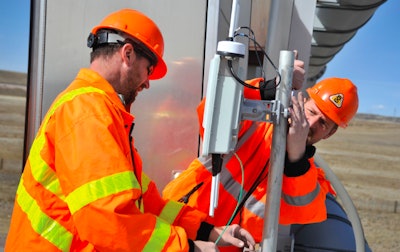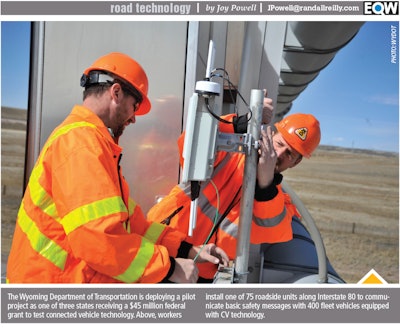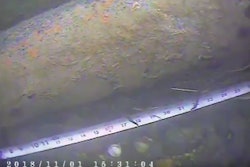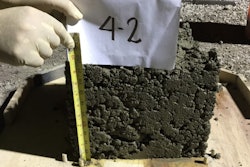

Drivers will be alerted by an auditory, a visual sign or even a vibrating seat. If road crews’ vehicles, such as slow-moving striping trucks, are outfitted with this technology, the drivers could get the forward collision warning if outside vehicles are dangerously approaching a work zone. It’s possible that in the future, a flagger could have dedicated short-range communications beacons on wearable equipment, so that information would be broadcast out to the people on the roadside, too, not just the vehicles.
The connected vehicle (CV) technology can help combat the growing problem of drivers distracted by texting and infotainment systems causing work-zone accidents, says Gerald Ullman, a nationally recognized expert in work-zone safety and mobility management and control.
“We’ve already got test deployments out on the road, so that is pretty close to moving forward,” says Ullman, a senior research engineer at Texas A&M Transportation Institute. “We believe there will be pretty significant safety benefits to both the traveling public as well as the workers.”
It’s hoped the alerts can catch the attention of all drivers, but especially the distracted, says Craig Parker, vice president of Silver Star Construction in Oklahoma City and chairman of the National Asphalt Pavement Association.
Since April 2017, when a distracted pickup-truck driver critically injured one of his flaggers, Parker has been on a quest, searching the internet and talking with traffic control companies, to find the latest Intelligent Transportation System technology to protect paving crews.
“I believe we will be seeing systems developed that could transmit information to cars alerting them to work zones, which would pop up warnings on the driver displays,” Parker says.
“Given distracted drivers are the largest safety problem facing the paving industry at this time, many of the industry equipment and safety suppliers are working on solutions to this problem. We will all have to help our customers – the DOTs, FHWA, cities, counties, etcetera – get these safety devices implemented on the projects.”
Connected vehicles collect information about weather conditions and other vehicles and transmit it every 10 seconds in a signal that also includes vehicle identification, such as Vehicle No. 1048, for example. The basic message is sent electronically between vehicles, and between vehicles and a roadside transmitter. The transmitter can also transmit information to be received by the vehicle.
Those brief messages could pop up in an infotainment system or in smartphone apps, Ullman says.
Wyoming project deploying CV technology
At the Wyoming Department of Transportation (WYDOT), Project Manager Ali Ragan agrees the emerging technology has potential to make roads safer for everyone, including road crews.
On Wyoming’s southern border, a connected-vehicle pilot program is being deployed along a 402-mile stretch of I-80, a major east-west corridor bearing more than 11,000 vehicles a day, including many freight trucks. Strong winds, snow, fog and low visibility contribute to multi-vehicle crashes and fatalities, she says.
WYDOT is equipping 400 snowplow trucks, patrol cars and private fleet trucks, as well as 75 roadside units with the technology, Ragan says. The vehicles and also roadside units will send and receive broadcast messages using dedicated short-range communications (DSRC), which operate on multiple channels on the 5.9 GHz radio frequency.
“One of our applications is specifically for work zones, and it can be used at the higher highway speeds,” Ragan says.
It can benefit workers on the ground as well as improve safety for people driving around or through the work zones, she says. Drivers will receive information about work-zone activities or restrictions.
“We can let them know about obstructions in the vehicle’s travel lane, lane closures, lane shifts, speed reductions, or if there are vehicles entering or exiting the work zone,” Ragan says.
The 75 roadside infrastructure units will be installed along the corridor based on identified hotspots for accidents or bad weather, she says.
Sponsored by the USDOT Joint Program Office for Intelligent Transportation Systems (ITS), the program’s goal is to pioneer deployment of connected vehicle technologies in three locations, which also include New York City and Tampa, Florida.
In Wyoming, Ragan says, about 300 of the 400 vehicles in the pilot belong to companies agreeing to work with WYDOT so their fleet drivers can see the safety benefit of connected vehicles. “And then we’ll be able to collect data to test the effectiveness of the system,” she says, noting that information will be shared with other states and agencies as part of the program.
In 2016, a total of 143 workers died in road construction accidents across the nation, according to the Federal Highway Administration.
“It’s a very dangerous job,” Ragan says. “We’re hoping to make it safer by using this technology to give drivers more information, so they can make travel decisions a little more quickly. They may be merging into the other lane sooner, which improves safety for the workers who are out on the roadway. We want to make it safer for drivers navigating a work zone.”
New era of Intelligent Transportation Systems
Connected vehicles are among Intelligent Transportation Systems technologies that integrate advanced communications technologies into transportation infrastructure and into vehicles.
Ragan says there’s much discussion among vehicle manufacturers about the best way to implement connected vehicle technology.
“There needs to be a rule basically that tells the automakers, ‘Put this on all your vehicles and start transmitting,’” Ullman suggests. “That was moving forward; we’re in a holding state right now because the current administration hasn’t made a decision on whether they want to make that rule happen or not. But even without it, some manufacturers are saying, ‘We’re just going to start doing it. At the very least, we can talk amongst our own vehicles, and if there’s other vehicles out there, we’ll start sharing information.’”
Toyota and Lexus recently announced plans to deploy DSRC systems on vehicles sold in the United States beginning in 2021, with the goal of adoption across most of its lineup by the mid-2020s. Those manufacturers say DSRC represents a significant step forward in creating a safer and more efficient driving ecosystem – while also advancing connected and automated technology deployment.
Compared to connected-vehicle equipment, the driverless (autonomous) vehicles and truck platooning are further away from full deployment, with uncertainty surrounding their uses, and so far, some crashes generating concern.
“They’re hoping to be able to limit where they do autonomous vehicle operations to lower-speed roadways and then watching for signs that say work zones,” Ullman says. “And as soon as they see work zone, they say, ‘Hey, you take over, I don’t know what to do.’”
Tesla and Cadillac and some other vehicles already offer driver assistance services or options on their vehicles, which is a level of autonomous vehicle operation, he notes.
Better work-zone documenting needed
“The big push in the work-zone arena right now is recognizing that we need to come up with a mechanism to capture exactly what is going to be done and also what is actually being done in almost real time,” Ullman says of work-zone data.
Some agencies are working with smartphone apps that, for example, enable the contractor to tap in the location of a lane closure and send it to a computer, then send another message when the job is done. Entering such data might soon be included in bid specifications, he says.
“In the fairly short near term,” Ullman says, “it will start affecting how contractors have to bid their jobs. You’ll have to take that requirement into consideration when you’re doing your estimates.”
Eventually, he predicts, performance requirements might be tied to that. “If you get out there and don’t tell us ahead of time, and you don’t document when you get out there, you might be penalized. Or maybe if you do it correctly, there’s an incentive to providing good data,” he says.
Real-time data could benefit contractors
“Ultimately, it could positively affect the contractors themselves if there’s more accurate information about what’s going on out on the road,” Ullman says. “They can use that for estimating how long it’s going to take to run loads back and forth of concrete, and say, ‘I’m going to have to add another concrete truck because we’re having traffic backing up and that’s increasing travel times.’”
As the technology keeps information flowing about what road workers are doing and where, the workers’ impact on traffic could become predictive and useful for all drivers. Those who check their routes beforehand could divert if they see a work zone, for example, and that could lessen traffic flow into the work zone, improving both the flow and safety, Ullman notes.
The connected vehicle technology is expected to be used more within the next few years, he says, “as soon as we can start doing a better job of getting data about actual work-zone times and locations and impacts. We’ve got navigational aids – Google Traffic and WAZE – and all these companies that are taking data right now and already rerouting. If they could detect a big backup, for example, they’ll say, ‘Hey, go this way.’”
For road crews, their part may be as simple as punching information into a smartphone, he says.
A few DOTs require such compliance already. In California, for example, Caltrans requires contractors to submit requests for approval for where they want to do roadwork days in advance. When they get to the work zone, they call it in. Caltrans is working on how to accept the information via text or a phone. Virginia is working on a similar application.
The process will also become more widespread, Ullman predicts, as the Federal Highway Administration’s data initiative, which began about a year ago, continues to move forward.
“We’re hoping to make the roadway safer for everyone,” says Ragan. “We think this technology really has the potential to make it safer on the roadsides for the people who are out there doing the work, and not just while they’re out there but while they’re traveling to and from a worksite.”










